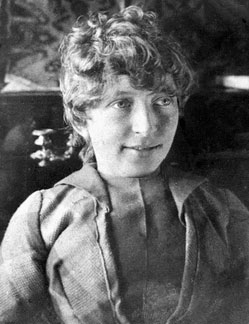Cecilie Thoresen Krog facts for kids
Quick facts for kids
Cecilie Thoresen Krog
|
|
|---|---|

Cecilie Thoresen Krog
|
|
| Born |
Ida Cecilie Thoresen
7 March 1858 Eidsvoll, Norway
|
| Died | 13 November 1911 (aged 53) Kristiania, Norway
|
| Nationality | Norwegian |
| Occupation | Feminist pioneer |
| Known for | She passed the examen artium in 1882, as the first Norwegian woman |
| Spouse(s) | Fredrik Arentz Krog |
| Children | Helge Krog |
| Relatives | Gina Krog (sister-in-law) |
Ida Cecilie Thoresen Krog (born Thoresen; 7 March 1858 – 13 November 1911) was a brave Norwegian woman who fought for women's rights. She was also a politician for the Liberal Party. Cecilie became famous as the very first woman in Norway to study at a university.
She made history in 1882 when she was finally allowed to take the examen artium. This was a special exam needed to get into university. Cecilie was a leader in women's rights groups. She was the first president of the Skuld association. Later, she helped start and became vice president of the Norwegian Association for Women's Rights. She also helped create the Norwegian Women's Public Health Association.
Cecilie was very active in politics. Her strong beliefs in freedom and equality shaped her work for women. In 1901, she was elected as a deputy representative in the Christiania City Council. This made her one of the first women in Norway to hold a political job.
About Cecilie's Life
Cecilie was born in Eidsvoll, Norway. Her father, Nils Windfeldt Thoresen, was a doctor. Her mother was Marie Johanne Benneche. Cecilie grew up with one sister and three brothers.
When she was young, Cecilie loved skiing, even ski jumping! In 1887, she married Fredrik Arentz Krog, who was a lawyer. They had a son named Helge Krog, who became a journalist and writer. Cecilie's sister-in-law was Gina Krog, another important women's rights activist. Cecilie passed away in Kristiania (now Oslo) in 1911.
Cecilie's Fight for Education
Cecilie went to private schools and finished Nissen Girls School in 1879. She really wanted to take the examen artium, which was a big step to get into university. But the rules made it difficult for women.
Her father wrote to the Norwegian Ministry of Education to ask if she could take the exam. His request was turned down. So, Cecilie then contacted the Minister of Church directly. The Minister asked the Royal Frederick University (now the University of Oslo) for their opinion. The university said no to women taking the exam.
But Cecilie didn't give up! She reached out to Hagbard Emanuel Berner, a member of the Parliament of Norway. He suggested a special change to the law just for her. This change passed in 1882. Thanks to this new law, Cecilie was finally allowed to take the examen artium. She passed it in 1882, becoming the first Norwegian woman to do so!
After passing the exam, Cecilie started studying science. She studied at the University of Oslo and later at the University of Copenhagen. She stopped her university studies in 1887 when she got married. She then had three children in the next three years.
Working for Women's Rights
Even after her studies, Cecilie continued to work for women's rights. She was a board member of the Norwegian Association for Women's Rights from the very beginning in 1884. She also joined the board of the Norwegian Women's Public Health Association when it started in 1896. In 1904, she helped create the Norwegian National Women's Council. Cecilie Thoresen Krog truly helped open doors for women in Norway.

